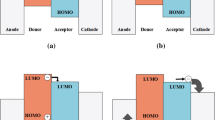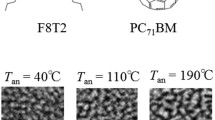Abstract
Bulk heterojunction organic solar cells (OSCs) based on the blend of poly(2-methoxy-5(2′-ethyl-hexyloxy)-1,4-phenylenevinylene (MEH-PPV) and [6,6]-phenyl C61 butyric acid methyl ester (PCBM) with different weight ratios (from 1:3 to 1:5) have been fabricated and the effect of annealing treatment on the performance of OSCs has also been studied. Experimental results point to the best optimized doping concentration 1:4 for MEH-PPV:PCBM. Furthermore, it is found that the devices with annealing treatment at 150°C with 8 min show better performance compared with the devices without treatment. The series resistance (R s) is decreased, while the shunt resistance (R sh) increased by nearly 1.5 times. The short-circuit current density (J sc) and fill factor (FF) are improved by annealing treatment. As a result, the power conversion efficiency (PCE) of the devices increases from 0.49 % to 1.21 % with the ratio of 1:3 and from 1.09% to 1.42% with the ratio of 1:4.
Similar content being viewed by others
References
Brabec C J, Sariciftci N S, Hummelen J C. Plastic solar cells. Adv Funct Mater, 2001, 11: 15–26
Coakley K M, McGehee M D. Conjugated polymer photovoltaic cells. Chem Mater, 2004, 16: 4533–4542
Brabec C J. Sol energy mater sol cells. Organic Photovoltaics: Technol Market, 2004, 83: 273–292
Tao H, Zhang F J, Xu Z. Effect of UV-ozone treatment on ITO and post-annealing on the performance of organic solar cells. Synthetic Met, 2009, 159: 754–756
Shaheen S E. 2.5% efficient organic plastic solar cells. Appl Phys Lett, 2001, 78: 841–843
Padinger F, Rittberger R S, Sariciftci N S. Effects of postproduction treatment on plastic solar cells. Adv Funct Mater, 2003, 13: 85–88
Walduf C, Schilinsky P, Hauch J, et al. Polymer photovoltaic detectors: Progress and recent developments. Thin Solid Films, 2004, 451–452: 105–108
Yu G, Gao J, Hummelen J C, et al. Polymer photovoltaic cells: Enhanced efficiencies via a network of internal donor-acceptor heterojunctions. Science, 1995, 270: 1789–1791
Sariciftci N S, Smilowitz L, Heeger A J, et al. Photoinduced electron transfer from a conducting polymer to buckminsterfullerene. Science, 1992, 258: 1474–1476
Kim H, Kim J Y, Lee K, et al. Organic photovoltaic cells based on conjugated polymer/fullerene composites. Curr Appl Phys, 2001, 1: 139–143
Yang F, Shtein M, Forrest S R. Controlled growth of a molecular bulk heterojunction photovoltaic cell. Nat Mater, 2005, 4: 37–41
Green M A, Emery K, Hisikawa Y, et al. Short communication solar cell efficiency tables (version 30). Prog Photovolt-Res Appl, 2007, 15: 425–430
Koch N. Organic electronic devices and their functional interfaces. Chem Phys Chem, 2007, 8: 1438–1455
Zhang F J, Aollmer A, Zhang J, et al. Energy level alignment and morphology of interfaces between molecular and polymeric organic semiconductors. Org Electron, 2007, 8: 606–614
Zhang F J, Zhao S L, Xu Z, et al. Transient demonstration of exciton behaviours in solid state cathodoluminescence under different driving voltage. Chin Phys, 2007, 16: 1464–1466
Reyes-Reyes M, Kim K, Carroll D L. High-efficiency photovoltaic devices based on annealed poly(3-hexylthiophene) and 1-(3-methoxycarbonyl)-propyl-1-phenyl-(6,6)C61 blends. Appl Phys Lett, 2005, 87: 083506
Chu C W, Yang H C, Hou W J, et al. Control of the nanoscale crystallinity and phase separation in polymer solar cells. Appl Phys Lett, 2008, 92: 103306
Ma W L, Yang C Y, Gong X, et al. Thermally stable, efficient polymer solar cells with nanoscale control of the interpenetrating network morphology. Adv Funct Mater, 2005, 15: 1617–1622
Zhang G, Li W L, Chu B, et al. Cascade-energy-level alignment based organic photovoltaic cells by utilizing copper phthalocyanine as bipolar carrier transporting layer. Appl Phys Lett, 2009, 94: 143302
Krebs F C, Bagger N C, Anderson M, et al. Lifetimes of organic photovoltaics: Photochemistry, atmosphere effects and barrier layers in ITO-MEHPPV:PCBM-aluminium devices. Sol Energy Mater Sol Cells, 2005, 86: 499–516
Bundgaard E, Krebs F C. Large-area photovoltaics based on low band gap copolymers of thiophene and benzothiadiazole or benzo-bis (thiadiazole). Sol Energy Mater Sol Cells, 2007, 91: 1019–1025
Koch N, Elschner A, Rabe J P, et al. Work function independent hole-injection barriers between pentacene and conducting polymers. Adv Mater, 2005, 17: 330–335
Al-Dmour H, Taylor D M. Revisiting the origin of open circuit voltage in nanocrystalline-TiO2/polymer heterojunction solar cells. Appl Phys Lett, 2009, 94: 223309
Aernouts T, Geens W, Poortmans J, et al. Extraction of bulk and contact components of the series resistance in organic bulk donor-acceptor-heterojunctions. Thin Solid Films, 2002, 403–404: 297–301
Author information
Authors and Affiliations
Corresponding authors
Additional information
Supported by the National Natural Science Foundation of China (Grant Nos. 10774013 and 10804006), the National Natural Science Funds for Distinguished Young Scholar (Grant No. 60825407), the Major State Basic Research Development Program of China (Grant No. 2010CB327705), the Beijing Jiaotong University (Grant No. 2007RC065), the Research Fund for the Doctoral Program of Higher Education (Grant No. 20070004024), the Research Fund for the Youth Scholars of the Doctoral Program of Higher Education (Grant No. 20070004031), and the 111 Project (Grant No. B08002)
Rights and permissions
About this article
Cite this article
Song, J., Xu, Z., Zhang, F. et al. The effect of annealing treatment on the performance of bulk heterojunction solar cells with donor and acceptor different weight ratios. Sci. China Ser. G-Phys. Mech. Astron. 52, 1606–1610 (2009). https://doi.org/10.1007/s11433-009-0220-0
Received:
Accepted:
Published:
Issue Date:
DOI: https://doi.org/10.1007/s11433-009-0220-0




